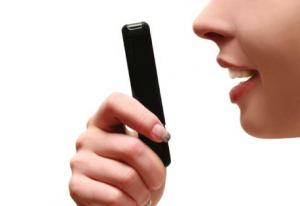Are you like me? Have you come to rely on talk-to-text on your phone? I am one of those people who use the microphone button on my iPhone to dictate my texts and m y searches. For the most part, my phone does pretty well at translating my voice into the written word. But like countless others, there are times when I re-read what I have written, only to find garbled text that barely resembles what I said. Sometimes I have to read it out loud to see if I can recapture the essence of what I was trying to say.
y searches. For the most part, my phone does pretty well at translating my voice into the written word. But like countless others, there are times when I re-read what I have written, only to find garbled text that barely resembles what I said. Sometimes I have to read it out loud to see if I can recapture the essence of what I was trying to say.
But even with that, I am one of many mobile phone users who have come to rely on this technology. What accounts for this reliance? Why are more and more people choosing voice-to-text? Here are the three top reasons:
- It’s fast – on average we speak about 150 words per minute vs. 25 typed on an iPhone or Android*
- It’s easy and convenient – because it’s hands-free, it’s easier to multitask, and if you’re driving, it’s a life-saver (literally – please note that I’m not advocating that you text and drive. It’s a no-no and even with voice, it’s probably illegal in many states)
- It’s smart – thanks to natural language recognition and processing, the more you use talk-to-text, the better your device understands you – thereby increasing it’s accuracy
With all these benefits it is clear that voice is rapidly becoming the most efficient way to interact with your mobile device.
But what about the question of accuracy? Technology improvements that address issues like background noise, accents and conceptual processing are changing how well our devices understand the spoken word. In 2010, statistics show that devices understood approximately 70% of what was said. Low enough that it pretty much defeated the purpose of talk-to-text. Because of technology improvements, in 2016, that number is over 90% and approaching 95%. When we hit that 95% mark, we won’t need to re-read our dictation and make corrections. That’s a game-changer.**
The point is, not only is talk-to-text here to stay, but it is going to play a much greater role in how the public interacts with their devices. More and more mobile websites will have easier to use voice interfaces, more programs and platforms will accept voice input, like Amazon’s Alexa/Echo devices or Apple’s Siri and more people will adopt a talk-to-text strategy when interacting with their devices.
Whether you use it to dictate text messages or shopping lists, or in the case of a product like EasyAsk, ask an eCommerce site to find you the perfect little black dress that exactly fits your size and budget, you’ll soon find that no matter how silly you think you look talking to your phone, you aren’t alone.
Oh, and here’s a tip – did you know that you can speak your punctuation when you use talk-to-text? For example for that previous sentence, I dictated, “Oh comma and here’s a tip dash did you know that you can speak your punctuation when you use talk dash to dash text question mark”. Go ahead, give it a try. Your phone won’t bite.
* https://www.pocketables.com/archives/mobile-device-keyboard
** kpcb.com/InternetTrends, Global Internet Trends, Mary Meeker, page 118
